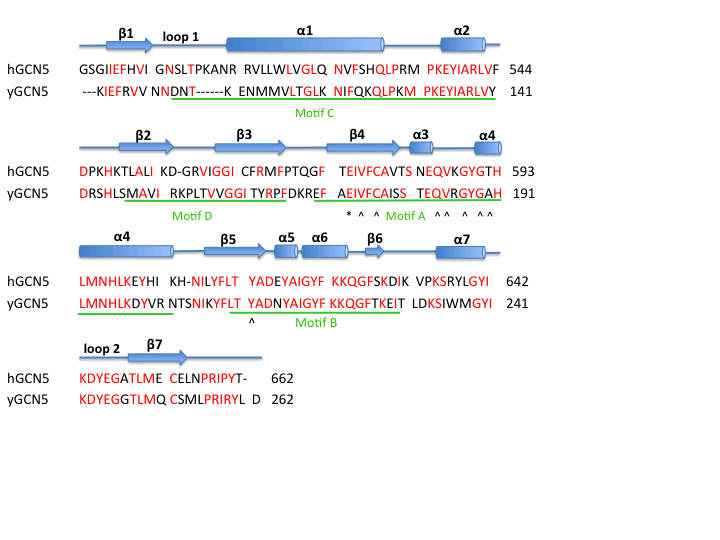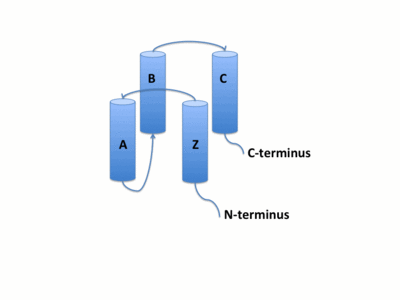User:Jamie Abbott/Sandbox1
From Proteopedia
| Line 54: | Line 54: | ||
{{STRUCTURE_3d7c| PDB=3d7c | SCENE= }} | {{STRUCTURE_3d7c| PDB=3d7c | SCENE= }} | ||
| - | The bromodomain is a highly conserved domain found to be a part of many chromatin remodeling proteins | + | The bromodomain is a highly conserved domain found to be a part of many chromatin remodeling proteins and nearly all HAT structures contain a bromodomain. This 110 amino acid motif was originally identified as a sequence motif common to the Drosophila brahma and female-sterile homeotic proteins, the yeast SWI2/SNF2 proteins and the human CCG1 protein <ref>PMID: 11080160</ref><ref>PMID: 1346755</ref> |
| + | |||
| + | The bromodoamin of human GCN5 is 110 amino acids and forms a <scene name='User:Jamie_Abbott/Sandbox1/Bromo_domain_helices/2' target='1'>four-helix bundle</scene> (αZ,αA,αB,and αC). Helices αZ and αA are connected by the ZA loop while helices αB and αC are connected by the BC loop. The up-and-down four-helix bundle of the GCN5 bromodomain has left handed topology as a result of the orientation of the long ZA loop. Loops ZA and BC pack together to form a hydrophobic pocket that may be involved in protein-protein interactions.<ref>PMID: 10365964</ref> | ||
[[Image:Slide7.gif|thumb|left|upright=2.0|400px|'''Left-handed helix bundle''']] | [[Image:Slide7.gif|thumb|left|upright=2.0|400px|'''Left-handed helix bundle''']] | ||
| Line 64: | Line 66: | ||
<Structure load='3d7c' size='300' frame='true' align='left' caption='Human GCN5 Bromo Domain' scene='Insert optional scene name here' /> | <Structure load='3d7c' size='300' frame='true' align='left' caption='Human GCN5 Bromo Domain' scene='Insert optional scene name here' /> | ||
| + | |||
| + | |||
| + | ---- | ||
| + | |||
| + | |||
| + | |||
| + | == PCAF_N Domain == | ||
| + | |||
| + | |||
| + | |||
| + | === Post === | ||
| + | |||
Revision as of 00:59, 3 May 2011
Contents |
Histone Acetyltransferase GCN5
Histone Acetyltransferase (HAT) GCN5 is a ~94 kD (837 amino acid) protein. It is a nuclear HAT or A-type HAT. GCN5 belongs to the GCN5-related N-acetyltransferase (GNAT) superfamily that includes the HATs, aminoglycoside N-acetyltransferases, mycothiol synthase, protein N-myristoyltransferase, and the Fem family of amino acyl transferases.[1] Most if not all HATs function in vivo as members of often large multisubunit complexes, many of which were initially characterized as transcriptional regulators. GCN5 has been shown to be part of the STAGA (SPT3-TAFII31-GCN5-L acetylase)[2] complex as well as the TFTC (TATA-binding protein-free TAFII containing)[3] complex.
GCN5 catalyzes the acetylation of specific Lysine residues of histones H3 and H4. Acetylation results in the neutralization of charged lysine residues which is hypothesized to weaken histone:DNA contacts[4] as well as alter histone:histone interactions[5]. Chromatin modification more specifically reversible histone acetylation has been associated with gene activation and consequently transcriptional activity for many years.
HAT Domain
The HAT domain of human GCN5 [6] consists of amino acid residues 496-658 with mixed α/β topology. This mixed α/β structure consists of 7 and 7 anti-parallel . AcCoA is bound via hydrogen bonds in a cleft on the surface of the protein. Residues involved in AcCoA include Val587, Gly589, Gly591, Thr592, Cys579, and Tyr617. There are two long flexible loops in the HAT domain. links helix α1 and strand β1. connects helix α7 and strand β7 and has been associated with substrate binding and specificity. [7] [8]
|
Catalysis
GCN5 catalyzes the transfer of an acetyl group from acetyl coenzyme A () onto the ε-amino group of specific lysine residues present in the amino-terminal tails of each of the core histones, H3 and H4, resulting in the neutralization of a single positive charge. [9] Currently, it has been demonstrated that the catalytic mechanism for yeast GCN5 involves a glutamic acid -173 residue, that acts as a general base. The Glu173 residue must deprotonate the ε-amino group of Lys14 of histone H3 prior to attack on the carbonyl carbon of AcCoA. [10] Comparing the sequence of human GCN5 HAT domain with yeast GCN5 strongly suggests that the catalytic mechanism of acetylation would be very similar. The conserved glutamic acid -173 of yeast GCN5 aligns with glutamic acid -575 of human GCN5 and therefore most likely functions as the general base in acetylation of histones H3 and H4.
Bromo Domain
The bromodomain is a highly conserved domain found to be a part of many chromatin remodeling proteins and nearly all HAT structures contain a bromodomain. This 110 amino acid motif was originally identified as a sequence motif common to the Drosophila brahma and female-sterile homeotic proteins, the yeast SWI2/SNF2 proteins and the human CCG1 protein [11][12]
The bromodoamin of human GCN5 is 110 amino acids and forms a (αZ,αA,αB,and αC). Helices αZ and αA are connected by the ZA loop while helices αB and αC are connected by the BC loop. The up-and-down four-helix bundle of the GCN5 bromodomain has left handed topology as a result of the orientation of the long ZA loop. Loops ZA and BC pack together to form a hydrophobic pocket that may be involved in protein-protein interactions.[13]
The bromodomain is separated from the HAT domain by 57 amino acids residues which contain an ADA2 interaction domain.[14]
|
PCAF_N Domain
Post
Evoultionary Conservation
References
- ↑ Vetting MW, S de Carvalho LP, Yu M, Hegde SS, Magnet S, Roderick SL, Blanchard JS. Structure and functions of the GNAT superfamily of acetyltransferases. Arch Biochem Biophys. 2005 Jan 1;433(1):212-26. PMID:15581578 doi:10.1016/j.abb.2004.09.003
- ↑ Martinez E, Kundu TK, Fu J, Roeder RG. A human SPT3-TAFII31-GCN5-L acetylase complex distinct from transcription factor IID. J Biol Chem. 1998 Sep 11;273(37):23781-5. PMID:9726987
- ↑ Brand M, Yamamoto K, Staub A, Tora L. Identification of TATA-binding protein-free TAFII-containing complex subunits suggests a role in nucleosome acetylation and signal transduction. J Biol Chem. 1999 Jun 25;274(26):18285-9. PMID:10373431
- ↑ . PMID:5339769
- ↑ Wolffe AP, Hayes JJ. Chromatin disruption and modification. Nucleic Acids Res. 1999 Feb 1;27(3):711-20. PMID:9889264
- ↑ Schuetz A, Bernstein G, Dong A, Antoshenko T, Wu H, Loppnau P, Bochkarev A, Plotnikov AN. Crystal structure of a binary complex between human GCN5 histone acetyltransferase domain and acetyl coenzyme A. Proteins. 2007 Jul 1;68(1):403-7. PMID:17410582 doi:10.1002/prot.21407
- ↑ Clements A, Poux AN, Lo WS, Pillus L, Berger SL, Marmorstein R. Structural basis for histone and phosphohistone binding by the GCN5 histone acetyltransferase. Mol Cell. 2003 Aug;12(2):461-73. PMID:14536085
- ↑ Poux AN, Marmorstein R. Molecular basis for Gcn5/PCAF histone acetyltransferase selectivity for histone and nonhistone substrates. Biochemistry. 2003 Dec 16;42(49):14366-74. PMID:14661947 doi:10.1021/bi035632n
- ↑ Schuetz A, Bernstein G, Dong A, Antoshenko T, Wu H, Loppnau P, Bochkarev A, Plotnikov AN. Crystal structure of a binary complex between human GCN5 histone acetyltransferase domain and acetyl coenzyme A. Proteins. 2007 Jul 1;68(1):403-7. PMID:17410582 doi:10.1002/prot.21407
- ↑ Tanner KG, Langer MR, Kim Y, Denu JM. Kinetic mechanism of the histone acetyltransferase GCN5 from yeast. J Biol Chem. 2000 Jul 21;275(29):22048-55. PMID:10811654 doi:10.1074/jbc.M002893200
- ↑ Owen DJ, Ornaghi P, Yang JC, Lowe N, Evans PR, Ballario P, Neuhaus D, Filetici P, Travers AA. The structural basis for the recognition of acetylated histone H4 by the bromodomain of histone acetyltransferase gcn5p. EMBO J. 2000 Nov 15;19(22):6141-9. PMID:11080160 doi:10.1093/emboj/19.22.6141
- ↑ Tamkun JW, Deuring R, Scott MP, Kissinger M, Pattatucci AM, Kaufman TC, Kennison JA. brahma: a regulator of Drosophila homeotic genes structurally related to the yeast transcriptional activator SNF2/SWI2. Cell. 1992 Feb 7;68(3):561-72. PMID:1346755
- ↑ Dhalluin C, Carlson JE, Zeng L, He C, Aggarwal AK, Zhou MM. Structure and ligand of a histone acetyltransferase bromodomain. Nature. 1999 Jun 3;399(6735):491-6. PMID:10365964 doi:10.1038/20974
- ↑ Candau R, Zhou JX, Allis CD, Berger SL. Histone acetyltransferase activity and interaction with ADA2 are critical for GCN5 function in vivo. EMBO J. 1997 Feb 3;16(3):555-65. PMID:9034338 doi:10.1093/emboj/16.3.555


